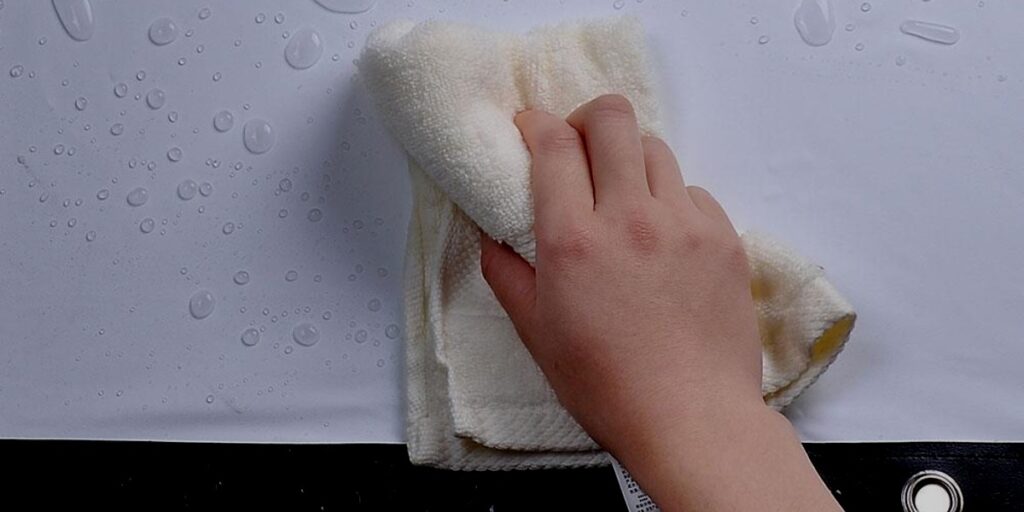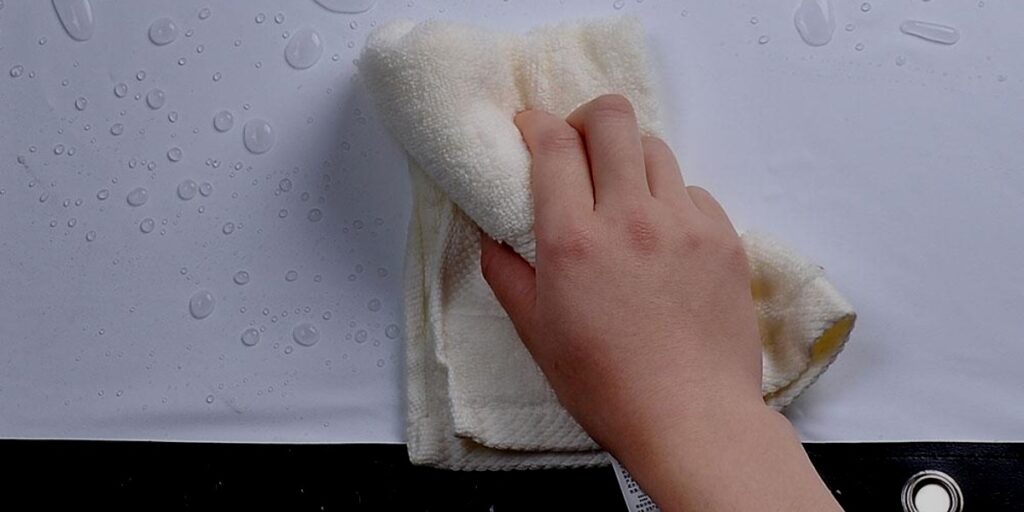
Introduction:
A clean projector screen is crucial for optimal viewing experience and picture quality. Over time, dust, fingerprints, and stains can accumulate on the surface, affecting the projected image. To maintain the performance of your projector and enjoy clear visuals, it’s essential to know how to properly clean your projector screen. In this article, we will walk you through the process, providing helpful tips and addressing common questions about projector screen cleaning.

Table of Contents:
- Why Cleaning Your Projector Screen Matters
- Precautions Before Cleaning
- Supplies Needed for Cleaning a Projector Screen
- How to Clean a Projector Screen? (Main Heading)
- Step 1: Assess the Screen Type
- Step 2: Dust Removal
- Step 3: Spot Cleaning
- Step 4: Deep Cleaning
- Dos and Don’ts of Projector Screen Cleaning
- Cleaning Different Types of Projector Screens
- Maintaining a Clean Projector Screen
- Frequently Asked Questions (FAQs)
- FAQ 1: Can I use regular household cleaners on a projector screen?
- FAQ 2: How often should I clean my projector screen?
- FAQ 3: Can I clean a motorized projector screen?
- FAQ 4: What should I do if my projector screen gets wet?
- FAQ 5: Can I use a vacuum cleaner to remove dust from the screen?
- FAQ 6: How do I remove stubborn stains from my projector screen?
- Conclusion
Why Cleaning Your Projector Screen Matters
A clean projector screen enhances the visual quality of your projector, allowing for sharper and more vibrant images. Dust, fingerprints, and smudges can obstruct the projected light, resulting in a dim and blurry image. By regularly cleaning your projector screen, you ensure a clear and captivating viewing experience.
Precautions Before Cleaning
Before diving into the cleaning process, it’s important to take some precautions to prevent any damage to your projector screen. Here are a few essential steps to follow:
- Power off the projector: Ensure that your projector is turned off and unplugged before attempting to clean the screen. This eliminates any risk of electric shock or damage to the device.
- Read the manufacturer’s instructions: Refer to the manual or guidelines provided by the manufacturer for specific cleaning instructions. Different screens may require different cleaning methods or products.
- Check for warranty information: If your projector screen is still under warranty, consult the warranty documentation to ensure that cleaning it yourself won’t void the warranty. Some screens may require professional cleaning to maintain warranty coverage.
Supplies Needed for Cleaning a Projector Screen
Gathering the right supplies beforehand will make the cleaning process smoother. Here’s a list of items you’ll need:
- Soft microfiber cloth: A clean, lint-free microfiber cloth is ideal for cleaning projector screens. Avoid using rough or abrasive materials that can scratch the screen surface.
- Distilled water: Distilled water is free from impurities that can leave residue or cause damage. It is safe to use for gentle cleaning of the screen.
- Isopropyl alcohol: Isopropyl alcohol is effective for removing stubborn stains and disinfecting the surface. However, it should be used sparingly and only when necessary.
- Compressed air or blower: A can of compressed air or a blower can be used to remove loose dust and debris from the screen surface before cleaning.
How to Clean a Projector Screen? (Main Heading)
Step 1: Assess the Screen Type
The first step is to determine the type of projector screen you have. Screens can be classified as either tensioned or non-tensioned. Tensioned screens have a smooth and taut surface, while non-tensioned screens may have a slight texture. Knowing your screen type will help you choose the appropriate cleaning method and products.
Step 2: Dust Removal
Dust particles are common culprits that can degrade the projected image. To remove dust from your projector screen, follow these steps:
- Use a can of compressed air or a blower to blow off loose dust particles gently. Hold the can or blower at a safe distance from the screen to avoid causing any damage.
- Starting from the top, wipe the screen in a gentle, downward motion using a soft microfiber cloth. Continue this motion until you have covered the entire screen.
- Pay extra attention to the edges and corners, where dust tends to accumulate. Use a soft brush or a clean, dry microfiber cloth to reach those areas.
Step 3: Spot Cleaning
If you notice fingerprints or smudges on your projector screen, you can spot clean those areas using the following method:
- Moisten a clean microfiber cloth with distilled water. Ensure that the cloth is damp but not dripping wet.
- Gently dab the affected areas with the damp cloth, using light pressure. Avoid rubbing vigorously, as it may smear the marks or damage the screen.
- After spot cleaning, use a dry microfiber cloth to remove any excess moisture from the screen. Make sure the cloth is completely dry to prevent streaks or water spots.
Step 4: Deep Cleaning
For more stubborn stains or dirt buildup, a deep cleaning may be necessary. Follow these steps:
- Create a cleaning solution by mixing equal parts distilled water and isopropyl alcohol. If your screen manufacturer recommends a different solution, follow their guidelines.
- Moisten a clean microfiber cloth with the cleaning solution. Again, ensure the cloth is damp and not excessively wet.
- Gently wipe the entire screen surface in a horizontal or vertical motion. Avoid applying excessive pressure or scrubbing too hard, as it may damage the screen.
- Once you’ve covered the entire screen, use a dry microfiber cloth to remove any residual moisture. Allow the screen to air dry completely before using the projector again.
Dos and Don’ts of Projector Screen Cleaning
To ensure the longevity and optimal performance of your projector screen, keep these dos and don’ts in mind:
Dos:
- Do clean your projector screen regularly to maintain image quality.
- Do use a soft microfiber cloth for cleaning.
- Do use distilled water for gentle cleaning.
- Do follow the manufacturer’s guidelines for cleaning.
- Do handle the screen with clean hands to avoid leaving fingerprints.
Don’ts:
- Don’t use rough or abrasive materials that can scratch the screen.
- Don’t spray cleaning solutions directly onto the screen.
- Don’t use excessive moisture that can damage the screen.
- Don’t clean the screen while the projector is on or connected to power.
- Don’t use ammonia-based or harsh chemical cleaners.
Cleaning Different Types of Projector Screens
Different types of projector screens require specific cleaning approaches. Here are some common projector screen types and tips for cleaning them:
- Matte white screens: These screens have a textured surface that scatters light evenly. Clean them following the general cleaning steps outlined earlier.
- High-contrast screens: High-contrast screens have a gray or black surface designed to enhance image contrast. Cleaning these screens requires extra caution as they are more delicate. Follow the manufacturer’s instructions for cleaning high-contrast screens.
- Acoustically transparent screens: These screens allow sound to pass through while maintaining image quality. Use a soft brush or a clean microfiber cloth to remove dust and gently spot clean with distilled water if needed.
- Motorized screens: Motorized screens may have different cleaning requirements depending on the mechanism and fabric used. Refer to the manufacturer’s guidelines or seek professional cleaning for motorized screens.
Maintaining a Clean Projector Screen
To keep your projector screen in pristine condition, follow these maintenance tips:
- Avoid touching the screen surface with bare hands. Oils and dirt from your fingers can leave smudges and affect the image quality.
- Keep the surrounding area clean and dust-free to minimize dust accumulation on the screen.
- Store the projector screen properly when not in use. Roll it up or retract it according to the manufacturer’s instructions to prevent damage or creases.
- Regularly inspect the screen for any signs of damage or wear. If you notice any issues, consult the manufacturer or a professional for repairs.
want to learn more about projectors?
Conclusion
Keeping your projector screen clean is essential for maintaining optimal image quality and overall performance. By following the proper cleaning methods, using appropriate supplies, and taking necessary precautions, you can ensure that your projector screen remains spotless. Regular maintenance and gentle cleaning will extend the lifespan of your screen, allowing you to enjoy crisp and vibrant visuals for years to come.
Frequently Asked Questions (FAQs)
FAQ 1: Can I use regular household cleaners on a projector screen?
It is generally not recommended to use regular household cleaners on a projector screen. These cleaners often contain harsh chemicals that can damage the screen surface. Stick to using distilled water or a manufacturer-recommended cleaning solution for safe and effective cleaning.
FAQ 2: How often should I clean my projector screen?
The frequency of cleaning depends on various factors such as the environment, usage, and screen type. As a general guideline, aim to clean your projector screen every few months or whenever you notice visible dust, fingerprints, or stains.
FAQ 3: Can I clean a motorized projector screen?
Cleaning a motorized projector screen may require extra care, as the mechanism and fabric can be delicate. It’s best to consult the manufacturer’s instructions or seek professional cleaning for motorized screens to avoid any damage.
FAQ 4: What should I do if my projector screen gets wet?
If your projector screen gets wet, first power off and unplug the projector. Use a clean, dry microfiber cloth to gently blot the moisture. Allow the screen to air dry completely before using it again to avoid any damage or water stains.
FAQ 5: Can I use a vacuum cleaner to remove dust from the screen?
Using a vacuum cleaner is not recommended for removing dust from a projector screen. The suction force of a vacuum cleaner can potentially damage the delicate screen surface. Stick to using a can of compressed air or a blower to gently remove loose dust.
FAQ 6: How do I remove stubborn stains from my projector screen?
For stubborn stains, create a cleaning solution by mixing equal parts distilled water and isopropyl alcohol. Moisten a clean microfiber cloth with the solution and gently wipe the affected area. Avoid rubbing too hard, as it may damage the screen. Follow up with a dry microfiber cloth to remove excess moisture.
Do you want to explore world? please visit